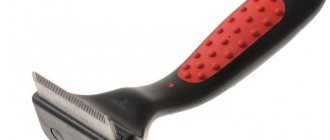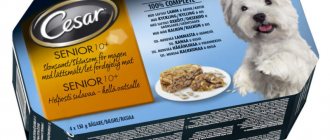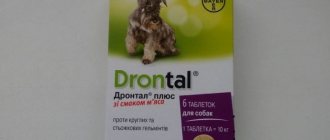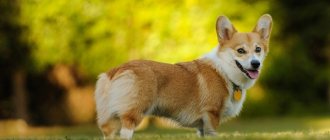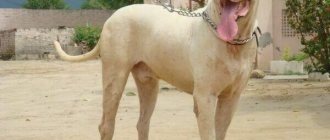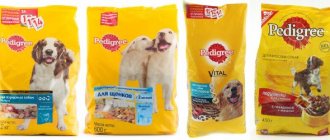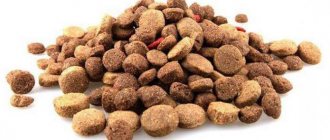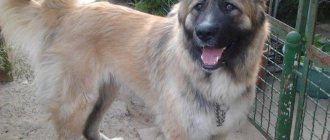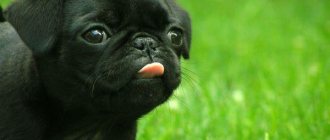- Dog breeds
The Newfoundland is a large, strong, resilient and calm dog. Many people choose this breed because the Newfie will never cause harm and will always be patient with all family members. This is a family dog that is suitable even for beginners. But it is necessary to take into account its size and educate it from childhood, explaining what is possible and what is not. This dog has only one drawback - a short life expectancy of 8-10 years. The larger the individual, the shorter the life expectancy.
- Country of origin : Canada
- Height at withers : male: from 69 cm, female: from 66 cm
- Average weight : from 54-68 kg
- Lifespan : 8-10 years
- Use : Companion Dog
- Other names : Newf
The most important feature of the Newfoundland is its character: calm, patient, balanced and gentle friend to all family members. However, if his family is in danger, he will be able to protect.
History of the breed
The Newfoundland breed was bred on the island of the same name. In the 17th century, this breed was very popular in Britain, but until the 18th century it did not have an official name. In addition, the Newfoundland was on the verge of extinction.
5 years after receiving the official name, the dog was on the verge of extinction. And all because the governor of the island issued a decree according to which one family could only have one dog, and all others had to be gotten rid of. Fortunately, many people hid their pets that they could not part with. This is no wonder, the good-natured giants helped their owners with housework. They perfectly transported heavy loads, helped in fishing (pulled out nets) and repeatedly saved the lives of their owners. The second wave of extinction occurred during the First and Second World Wars, when many dog breeds were on the verge of extinction, as no one needed them.
Only thanks to enthusiastic breeders, Newfoundlands were saved and we can now enjoy this large and good-natured dog.
The Moscow Diver (a breed that no longer exists) is not a Newfoundland . Until the 50s, Newfoundlands were a very rare breed in Russia. In domestic publications they were called divers (for example, in “Heart of a Dog” by M. Bulgakov). The breed is bred by the USSR nursery "Red Star". The nursery began an experiment to breed the “Moscow Diver” breed based on Newfoundlands. "Red Star" wanted to breed a new breed of dogs with protective and security qualities. To achieve this, Newfoundlands were crossed with Caucasian Shepherds, but the result was unsatisfactory and breeding of the breed was stopped.
History of the origin of the Newfoundland dog breed
This breed originated on the island of Newfoundland in Canada, which is why it is called that. The first mention of fluffy dogs that swim well dates back to the 18th century. They were described as smart and good-natured, with developed working qualities. These large dogs helped fishermen pull out nets, carry loads, and rescue drowning people.
Local residents selected individuals with endurance, loyalty, obedience, and withstanding harsh climatic conditions. The result was a completely non-aggressive dog with webbed paws and thick hair with water-repellent properties. She was devoted, willingly serving people. The unique feature of her sense of smell allowed her to find a person by smell in the water and pull him out without injuring her teeth.
There are several versions of what breeds were the ancestors of the Newfie. Many dog experts believe that they descended from Molossians and other mastiff-like large dogs brought to the island by the Vikings. They crossed with local sled breeds. There are different opinions that the ancestors of Newfoundlands were wolves, shepherd dogs, huskies, Tibetan mastiffs or Pyrenees mountain dogs. Another version is that the breed formed independently. For a long time, these dogs lived near the sea, so they acquired such features as webbed paws and water-repellent properties of the coat.
Newfoundlands took the best qualities from their ancestors. Already at the end of the 18th century, they attracted dog breeders with their friendliness and desire to help people. They began to be exported to England and were given the name “Newfoundland”. But it was only towards the end of the 19th century that the breed became popular. Clubs began to be created, and the first standard was developed. The breed has spread throughout the world.
These large dogs appeared in Russia at the beginning of the 20th century, but did not become popular. They began to be imported en masse after World War II. Then dog handlers tried to breed a new breed. Newfies were crossed with shepherd dogs and were called Moscow divers. But they turned out to be aggressive and were not suitable for guard duty.
The experiments were stopped, and in the 80s they began to import Newfoundlands from abroad. Now the breed is popular in Russia. It meets international standards. But these dogs are still called divers.
Old pictures show that Newfoundlands have always served man:
Old picture of the Newfoundland breed
Old picture of the diver breed
Old picture of the Newfoundland breed
Newfoundland character
- good-natured
- Balanced
- Friendly
- Lack of aggression towards people
- Calm
- Devoted
- Always ready to help
The Newfoundland is a large dog with a very calm and good-natured character. They do not show aggression towards people and that is why you should not expect them to protect the territory. This breed of dog belongs to the “Companion Dog” category. However, one should not think that they will simply stand and watch if the owner is in danger.
Many owners note the courage of these animals. They won’t be able to bite, but they can knock the enemy onto his back and render him harmless.
Character
The character of the Newfoundland is clearly evident from birth.
The breeder knows each baby and should help you choose the right pet. A good breeder will always ask a lot of questions before selling a dog. It is important to him what kind of hands the puppy will fall into and how suitable the dog and the future owner are for each other. The breeder will definitely tell you what to pay attention to so that life together is comfortable. Newfoundlands are very people-oriented, loyal, and affectionate. They literally look into the eyes of the owner, trying to guess his desires. When they meet, they are very happy and show all possible signs of attention.
However, a person must be a leader and set the rules. It is the person who makes the final decision on any issue. If this does not happen, the Newfoundland will take on the decision-making responsibility not for itself.
Breeder's observations: There was a case when, while walking with my daughter and one of our dogs in the forest, we came across a group of tipsy young people. They blocked the road and began to tease the dog. This dog always walked with my husband and respected him very much. But she decided that in the absence of her husband, she would make the decision, and she must protect us. Then the dog put its paws on one of the young men’s shoulders, forced it down to the ground with its weight and held it, showing with its eyes that my daughter and I could walk through. Then she simply stepped over the guy and continued walking. She made her own decision, but the consequences of such decisions can be different. Therefore, the dog must understand that any decision-making is controlled by the person.
.
Newfoundlands are very kind dogs. If they live in a closed area, they may bark at dogs running past, but this is not a sign of aggression. The example above proves that, if necessary, they can defend their owner. However, aggression is not typical for them.
Breeder's observations: An outbreak of aggression can sometimes “slip through” in dogs that were bred in the territory of the former USSR. At that time, it was not Newfoundlands that were bred, but an experimental breed - divers and guard dogs. The blood of Caucasian Shepherd dogs flowed. Outbursts of aggression among the descendants of Moscow divers are precisely the legacy of Caucasian Shepherd Dogs. But such a dog is potentially dangerous, given its enormous size and very powerful jaws.
However, this happens extremely rarely. Aggression is a vice for the Newfoundland. This dog is endowed with absolute trust in people and other animals. She is ready to greet and communicate with everyone. Newfoundlands get along well with other pets, including cats.
Nature has endowed Newfoundlands with extraordinary intelligence. To the point that they are able to develop cunning plans to achieve what they want.
Breeder's Observations: The Newfoundland cannot be called just a dog. This is a man in dog form. Newfoundland is a lifelong chess game, each dog is a new game. And when you come across a particularly tricky puzzle, you realize that they are smarter than us. I'm lucky to live next to them
.
Each Newfoundland is a personality with its own character. There are a lot of calm, balanced dogs. However, there are also very active Newfoundlands that can “drive” German shepherds in games.
Breeder's observations: Some dogs have a hard time being separated from their owner and can throw a real tantrum. There are Newfoundlands that cannot stand loneliness and can “destroy” an apartment. Gut the kitchen, take clothes from the top shelves. But this is more likely an individual feature, not a breed one.
.
Newfoundlands get along well with children, including strangers. They can take part in animal-assisted therapy programs. They tolerate everything, they are even ready to give children rides on their backs. If there is a child in the family, there is every chance that he and the Newfoundland will become inseparable friends. This is a nanny dog.
However, we should not forget that a dog is plasticine, and it will be exactly what a person makes it.
Newfoundland: breed features
- Tendency to excessive salivation . You must be prepared that the dog is very prone to salivation. In addition, they are difficult to remove from some types of fabrics and cannot even be washed. You will have to leave napkins and towels everywhere and wipe your face after every meal and drink. If there is drool on your clothes, you need to wipe them with a damp cloth and then wash them. Many Newfoundland owners recommend making them bandanas for walks. Owners also note that Mastino drool much more and you can choose a dog with a less loose muzzle or choose a female (they also have less problems with drooling).
- Lack of aggression towards people . However, when threatened, they can throw the enemy to the ground, but they would rather simply threaten than harm.
- A natural swimmer . There is no need to teach him how to save; he has a well-developed instinct for rescuing a person from the water.
- Can be kept in an apartment . Although the dog is large, it is calm and gets along well in an apartment. Don't forget about the fur, comb and clean it daily.
- Activity . Many people consider the Newfoundland to be too calm and even melancholic, but it is a very active animal that needs regular walks, physical and mental exercise.
- Newfoundlands rarely bark.
- They tolerate heat very poorly . It is necessary to understand that a dog is very vulnerable in the summer and cardiac arrest often occurs. In the summer, the Newfoundland should be at home under air conditioning, and not walk in the sun, have access to clean water, and best of all, to a swimming pool.
- Family dog . The Newfoundland gets along well with all family members and pets. He is a very loyal dog and cannot be left alone for a long time.
- Easy to train and suitable for beginners.
- Tend to make independent decisions . If they see danger, they are able to act quickly and decisively.
- They don't like loneliness . They get very sad and bored if they are left completely alone. They do not tolerate long separation from their owner well. They also do not tolerate a change of owner well. If you don't have time for a dog, then don't get one.
Raising a Newfoundland
From the first day it is necessary to raise and train the Newfoundland, explaining what is possible and what is not.
Breeder's recommendations: Sometimes they say: “A Newf should be as comfortable as slippers.” But this depends on how the dog is raised in the first months. The little Newf looks like a bear cub; you want to cuddle him endlessly. But you need not only to pet the puppy and play with him, but also to educate him. It is necessary to exercise until the dog becomes obedient
.
Newfoundlands are large dogs and people are often afraid of them. Do not forget that even if the dog simply takes a step towards an unfamiliar child, he may remain a stutterer.
An adult dog will try to take a leading position. A person must prove his dominance in the pack.
If you can’t cope on your own, seek help from a professional dog handler or animal psychologist.
Breeder's recommendation: The best option for motivation in training is to work on contact with the owner. I never work with my dogs “for treats”, although occasionally I can reward them. The dog should just be happy with its owner. They expect approval and praise. The dog must know that it is loved, and the owner must know that he is respected
.
Just because you have a Newfoundland doesn't mean it can save a drowning person. An untrained dog does not know how to act correctly and may not only not help, but also cause harm. And a drowning person can be scared of a dog. There are special schools where Newfoundlands are taught how to properly rescue people on the water. Training should be carried out by specialists. Unfortunately, there are no rescue Newfoundlands in Belarus yet.
Care and maintenance
- Wool . The Newfoundland has a luxurious coat and requires careful care. The coat should be of medium length, without unnecessary long and thin strands. It should be combed every 2-3 days. During the molting period, daily: morning and evening. From time to time you will have to visit a groomer or learn this profession yourself and cut your pet’s hair so that he looks chic all year round.
- Swimming . It is necessary to teach a puppy to swim at 3-4 months. Take you to the river more often. They already have the instinct to save a person in water, so you don’t even have to teach it. The only thing worth doing is to show the newfie something to grab with his teeth. Many victims, after being rescued, complained about the dogs because they bit their hands.
- Avoid intense workouts . You should not do intensive training/exercise at an early age, as this may affect the puppy's health. Don't force him to carry heavy loads until he is 2 years old.
- Bath . If the dog lives in an apartment, then you can bathe the dog once a month, although it is not advisable to bathe frequently. It is necessary to dry not with a hairdryer, but with a compressor. If you dry with a low-power hairdryer it will take about 3-5 hours.
To comb Newfoundland wool, you need to choose several brushes of different shapes and sizes:
- a brush with long teeth that will not bend, penetrate completely into the fur and will not injure the skin;
- puffers;
- metal comb with rare and frequent teeth;
- furminator (but not required).
- Dental care. It is enough to examine your Newfoundland's teeth and oral cavity once a week. As for the care itself, during a thorough examination you should pay attention to: The condition of the gums - if they are red and inflamed, it is recommended to contact a veterinarian who will recommend special medications or remedies;
- Teeth color – ideally, it should remain normal, without plaque (you can clean it yourself) and purulent formations. To maintain teeth in good condition, special bones and toothpastes for dogs can be very useful;
- Dental health – check for loose or broken teeth. Between them there should also be no food residues, the accumulation of which causes the animal to develop an unpleasant odor from the mouth and subsequently rot;
- The presence of tartar - in this case, it is impossible to do without the intervention of a veterinarian and its removal. It should also be noted that an important factor for the health of a Newfoundland - and in particular teeth - is proper balanced nutrition.
Remember that all dog grooming procedures help to establish a relationship with the dog and train him to be disciplined. Regular checking of your Newfoundland puppy will develop into a kind of obligatory and pleasant communication procedure. If you notice any changes in behavior or find any unexplained sores or redness, contact your veterinarian.
Caring for Newfoundland dogs
Caring for Newfoundlands is not easy. Thick fur sheds heavily and quickly becomes tangled. It needs to be brushed 3-4 times a week, and daily during shedding. You will need a stiff bristle brush, a long-toothed comb, and a slicker brush. In the summer, you can take your dog to a groomer for a short haircut.
The diver does not need to bathe frequently. Wool has the ability to repel not only moisture, but also dirt. Using shampoo when washing violates its protective properties. In the warm season, swimming in natural bodies of water is sufficient. After a walk, you need to wash your paws and wipe your face after eating. To protect the coat in dirty weather, it is better to put a blanket or raincoat on your dog.
You should regularly check your eyes and ears and wipe them with a napkin. If there is discharge, contact your veterinarian, who will recommend drops. You need to trim your nails once a month and brush your teeth every week.
Content Features
Despite the enormous size of the diver, you can keep it in an apartment, the main thing is that it is not small. But he feels best in a private house with a plot. Just don't put this dog on a chain. She still won’t make a watchdog, but this can break her psyche. After all, these dogs cannot live without human communication.
The Newfoundland needs space and freedom of movement. You need to make a comfortable place for him to sleep in the house. Preferably a spacious mattress with an orthopedic base. The cover should be easy to remove and wash. You also need to allocate a separate bowl for food and water, which is best placed on a special stand.
Newfoundlands are very calm and lazy dogs. They love to lie down, so it is necessary to walk them at least 2 times a day for an hour. Otherwise, the dog will gain excess weight. At least once a week you need to take your pet out into nature, give him the opportunity to run, and even better, swim.
The video will help you understand how to properly care for these dogs:
Video: 5 features of caring for a Newfoundland
Video: Grooming a large dog
Video: Walk by the river with Era. The spring weather is pleasant. We run, play, swim.
Health
The health of these dogs is rather poor and their life expectancy is short. On average, Newfies live 10 years, and if you make mistakes in keeping and feeding, then even less.
These dogs are prone to obesity and heart disease. Due to their massive build, they often develop arthritis and joint dysplasia. Their bones are not very strong, so injuries occur. In summer, overheating and heat stroke are possible. Newfies are also prone to eye diseases and ectropion.
Nutrition
The diet of this large dog must be balanced and contain enough protein. But Newfies are prone to obesity, so they should not be overfed. The easiest way to dose dry food is that an adult dog needs 500 g per day. They should be super-premium or holistic class, designed for large breeds.
With a natural diet, more than 50% of the diet should be lean meat, this is approximately 1-1.5 kg per day. Pork and fatty poultry are not recommended. You also need to give porridge - buckwheat, rolled oats or rice, fresh and boiled vegetables, except potatoes and legumes. Greens, fermented milk products, and sea fish are healthy. Sweets, smoked foods, pickles, canned food, sausages, fatty and fried foods are prohibited. Additionally, you need to give multivitamin complexes.
Health
Newfoundlands are susceptible to certain diseases.
- Addison's disease
- Cataract
- Cherry eye, known as third eyelid
- Subvascular aortic stenosis
- Epilepsy
- Dysplasia hip dysplasia
- Elbow dysplasia
- Hypothyroidism is a disorder of the thyroid gland
- Cystinuria is an inherited disease
- Cancer
- Volvulus of the stomach
Preventative measures to protect your Newfoundland puppy
- To keep your Newfoundland puppy completely safe, you first need to minimize his contact with unfamiliar dogs, especially strays. Therefore, you should not let your dog off the leash, as in this case it will become impossible to control its behavior and communication with other dogs. Since a dog can easily become infected with distemper from simply touching the nose of a sick animal. This disease can be transmitted to a dog through sniffing. Your dog can become infected with trichophytosis from contact with the lichen-affected fur of a sick dog. Naturally, it is impossible to completely exclude a dog’s communication with other dogs, since it must be socialized. Therefore, try to find friends with dog lovers who look after their animals. By adhering to this rule, you can eliminate the risk of pathogen transmission by 80%.
- You should walk your dog in places where there are no landfills. Since garbage very often attracts rodents, which in turn are very often carriers of various infections. Gray rats are especially dangerous because they carry such a serious disease as leptospirosis.
- You should not allow your dog to sniff other people's feces, as they are a source of worms.
- Monitor your Newfoundland's health. Pay attention to even the most minor changes in his behavior. For example, your dog may appear lethargic, lose his appetite, or have a dry nose. Or you may notice that the dog begins to shed, and this has nothing to do with seasonal shedding. If hair loss becomes excessive, this is the first symptom indicating health problems in your pet. And only you can help him. Therefore, it is important to take the dog to the veterinary clinic in time, where the disease can be overcome for sure. In no case should you ignore the symptoms, since advanced infections are much more difficult to treat, and sometimes even impossible. If you start treating your dog, the disease can lead to his death or he will develop serious complications that will affect his hearing, vision, limbs and much more.
Newfoundland in a city apartment. Conditions of detention.
Newfoundland in a city apartment.
Conditions of detention. Since ancient times, people have been using dogs to save people during natural disasters. If St. Bernards are considered the best rescuers in the mountains, then on the water they are Newfoundlands. A Newfoundland will, without hesitation, rush into the water at the mere hint that a person needs his help. These are very good-natured, brave, hardy dogs. They are considered a wonderful family dog.
History of the Newfoundland (Newfoundland, diver)
The roots of the origin of dogs of this breed go back to ancient times. It is difficult to accurately reconstruct the origin story. One thing is certain: the ancestors of this breed come from the island of Newfoundland. There are two most popular versions of the origin of Newfoundlands (divers).
The first suggests that long ago Pyrenean dogs crossed with dogs of breeds similar to huskies, which belonged to the Indians of North America.
The distinctive features of dogs resulting from such crossing are sullenness, love of water, extraordinary performance, intelligence and good nature.
The second version says that Newfoundlands originated from crossing an Asian mastiff with a black wolf, which has long been absent from the earth. Features such as endurance, intelligence, strength, courage, and the desire to always be close to a person stood out. The first representatives of this breed were assistants and faithful companions of fishermen and sailors.
Already in the seventeenth century, there was a description of the appearance of Newfoundlands, and they had been traded in Britain for a long time. This breed did not have its official name until the second half of the eighteenth century. In 1775, George Cartwright named his dog after the island where the breed originated. The absurdity was the fact that due to a government decree in their homeland, Newfoundlands almost disappeared!
According to the decree of Governor Edward in 1780, a family could only have one dog of this breed; the rest had to be taken out or destroyed!
The “justification” was the claim that such a measure would contribute to the growth of sheep farming. The consequences were tragic. The number of sheep has not increased, and the Newfoundland has practically disappeared in its homeland.
Many island residents did not comply with the decree due to the value and necessity of this breed of dog on the farm.
After all, these dogs were heavy haulers, transporting sleighs loaded with fish. Working on ships, they pulled heavy nets with fish, and they pulled out gear or fish that had fallen into the sea without any command, often rescuing fishermen who had fallen overboard. While on the ship, Newfoundlands felt the approach of land 16 kilometers away and reported this with a loud bark. And, being on the shore, they sensed the approach of ships at a great distance and also “reported” this.
They came to Western Europe at the beginning of the nineteenth century, quickly winning love and recognition. The black, large dogs were noticeably different from their brothers in intelligence, appearance, intelligence, and hard work. In addition, their innate love for water and instant reaction to a threat to the life of a drowning person completely won the hearts of Europeans. Innate intelligence, self-esteem, a combination of kindness and strength helped the “ship” dogs step into the imperial palaces and homes of people from high society.
Let us remember that when Napoleon Bonaparte drowned in the sea during his escape from the island of Elba, it was a diver who saved him. The favorite dog of the great English poet George Noel Gordon Byron was a Newfoundland named Botswane. The poet’s own statement about this breed of dogs sounds something like this: these dogs have beauty, but are not vain, they are strong, but not arrogant, they are courageous and at the same time modest. These noble animals have all the virtues of a person without vices.
You forgot to read Wash your dog correctly
Description of the Newfoundland breed
Newfoundland is not afraid of frost. This dog can swim safely in icy water. The special structure of the ears and paws, the presence of membranes between the fingers, the third eyelid - all this allows the diver to dive to a depth of up to thirty meters and calmly swim in cold water up to twenty kilometers.
The Newfoundland is a large dog, height at the withers is from 66 to 71 cm, while the weight is 54-68 kg. The most important thing is that height and weight are proportional. The dog’s muscles are dense and its body is powerful, which helps it not only be strong, but also make smooth, coordinated movements. The head is large with a pronounced occipital protuberance. Newfoundlands come in black, brown and black and white colors.
The nose is large, clearly pigmented depending on the coat color. Black and black and white Newfies have a black nose, while brown ones have a brown nose. The muzzle is short, fitting into a square, and the hair on it is short. The skin on the face should not have folds. The eyes are brown and deep set. Newfoundlands have small triangular ears. A long neck gives a dog a proud posture, which should not have exaggerated folds of fat.
The coat of these dogs is very long, thick and impermeable to water, as it has a double structure. But long hair is inherent only to the body of the dog, and on the face and ears it is short and velvety. There is a very soft undercoat. The dog's coat may have some waviness. The diver's coat is soft, silky, almost “oily” to the touch.
Newfoundland character
Newfoundland is a dog that is ready to help any person in trouble. The diver's character is calm, modest, and good-natured. A diver is able to make independent decisions in different life situations, forgetting about his own safety. These dogs lack the hunting instinct, so they make friends with other pets.
These dogs have no sense of aggression. They love people too much and therefore are not very suitable for the role of a security guard. But they are quite capable of pushing away a stranger and showing him their big strong teeth. Divers don't like to bark for no reason. They speak only when danger approaches in order to save or warn the owner. Many divers also do not have a sense of fear, so owners should teach puppies not to come close to a fire or a moving car.
Divers adore the company of their owner, listen to his every word and are very sad when he is not around. Prolonged separation can cause depression. These dogs are very playful and are suitable as nannies for children. Divers are easy to train, but do not tolerate rough and harsh treatment, so they must be trained gently. The owner will need to be patient and affectionate.
Caring for Newfoundlands
Owners of this breed of dog should be aware that divers shed throughout the year, so regular and thorough coat care is necessary. It must be combed daily with hard brushes and trimmed periodically. Bathing a dog, if it is not a show dog, is enough once a month. It is advisable to bathe with dry shampoos so that the coat does not lose its oil impregnation. You can use professional dog shampoos or very mild “human” ones if the dog is a show dog. Eye and ear care is also necessary.
You forgot to read Chihuahua is the smallest dog
Walking Newfoundlands
Although divers are too calm and even phlegmatic by temperament, they need walks and physical activity, swimming in open water. Unlike dogs of hunting breeds, divers' walks should not be so long and frequent, without special runs over long distances.
Feeding Newfoundlands. Main problems
The owner of a large dog needs to know that overeating is unacceptable for his pet! Extra pounds complicate walking, running, mobility, disrupt metabolism, leading to obesity, which threatens a number of diseases.
Main feeding problems:
1. Dietary disorder. 2. The diet is unbalanced, without vitamins and microelements. 3. Overeating.
What to feed your Newfoundland?
You can feed the diver with natural products and special dry food. It is important that the daily diet contains at least 45-50 percent meat, protein, vitamins and minerals. Let's talk about feeding an adult dog.
1. Cook porridge in meat broth with the addition of lean meats or offal. We remember that liver and kidneys are too high-calorie by-products, so we give them less. 2. Add boiled vegetables, vitamins and minerals to the porridge. 3. Don't forget about the need for calcium. Along with the porridge, we serve lean sea fish without bones. 4. Fermented milk products are required (low-fat kefir, cottage cheese, fermented baked milk). Milk is not digestible by adult dogs. 5. You can give fruits throughout the day. 6. It is better to feed not once, but several times a day. 7. If you give dry food, you need to know that the required amount is 500-600 grams per day. 8. Mandatory access to clean drinking water and feed. We remember the prohibitions: you cannot give fatty foods, fried foods, sweets, baked goods, smoked meats, sausages, sausages, canned food, bones.
Newfoundland Health
The lifespan of a Newfoundland is between eight and ten years. Main diseases: hip dysplasia, heat stroke in the hot season. Intestinal volvulus, cataracts, ectropion and entropion of the eyelid, aortic stenosis, etc. are common.
All of these diseases are more likely related to the size of the dog, and are not characteristic of this breed. Divers have a tendency to allergic reactions to medications, so at the slightest discomfort you should seek help from a veterinarian. Divers tend to drool profusely and need to wipe their mouth after each feeding.
Is your dream dog a water rescue dog? Do you need an attentive interlocutor, a calm and patient nanny for your children, a devoted, wise and courageous friend, ready to give his life for you in any danger? This is Newfoundland! Make a choice and you will never regret it!
voice
Article rating
Training and education
The Newfoundland is easy to train and suitable even for a beginner. He is ready to please his master, although he has a wayward character and is able to make his own decisions. But we must remember that when training, you cannot hit, scream or pronounce commands with anger. The breed is very calm and balanced and there is no need to constantly influence it. Training is carried out only on positive emotions, with praise and treats.
They cannot stand shouting or punishment from their owner . They are very impressionable and cannot stand rudeness. If the owner raises his voice at them, the pet may be offended for a long time.
They pass the OKD without any problems, but the ZKS is not worth even trying. As mentioned above, the dog is not aggressive towards people and there is no need to torture it. When defending, he makes all decisions independently. If you need a dog for protection, then you should turn your attention to other dog breeds.
Submitting a dog doesn't always work. The principle of complete submission of the Newfoundland to the owner is an outdated method. This theory was formulated based on observations of packs of wild wolves, but they were kept in captivity and, of course, experienced stress. The stress condition forced wolves to show aggression towards each other, but in the wild they do not show aggression to each other - they live together and interact with each other. You need to perceive yourself as the more experienced and mature member of the pack, who is responsible for guiding the new member (Newfoundland puppy) and teaching him good behavior, as well as correcting him if necessary. It is important to remember that Newfoundland puppies learn a lot on their own. They are very inquisitive, love to explore new territories and, of course, experiment. Puppies tend to repeat actions they enjoy (like playing with a toy). They do not repeat actions that cause them pain (for example, destroying a nest and getting bitten). If your Newfoundland puppy misbehaves, ignore him and praise him when he does the right thing. Reward your puppy for following commands and good behavior. Do not neglect these tips. After all, constantly hearing “you can’t” all day long is unbearable. This is a small child who wants to know everything and get his portion of treats as a reward for not eating your favorite rug, going to the toilet outside, bringing you a ball, and so on.
Set rules and monitor their implementation
It is worth enrolling your Newfoundland puppy in obedience training classes. These classes will allow you to understand exactly what actions will allow you to control your dog’s behavior. You will be able to spend more time with your puppy, establish contact and socialize around other dogs.
Adviсe
- Training a Newfoundland puppy should be done with the help of positive motivation; watch carefully special films about this technique. The Canine Translator film series from National Geographic is suitable.
- If you need to leave your puppy at home alone for 2 hours or more, then ask someone to come to him.
- Be sure to make an appointment with your Newfoundland puppy to see the vet as soon as possible. The doctor will carefully examine him and give him vaccinations that will protect him from dangerous diseases.
A good nursery, how to choose one
A specialized nursery is the best place to buy a good Newfoundland puppy. If pedigree and thoroughbred are important, then it is better to hire an experienced dog breeder to help. If not, then you can trust your heart. On nursery websites, there are customer reviews that will help you navigate. A little secret or life hack: visit a dog show where the desired breed will be presented. Chat with the owners of the breed, ask about the nuances, find out where they purchased the puppies. True dog breeders live for their pets, so they will be happy to answer any question and give valuable advice. Typically, nurseries send their representatives to exhibitions, where there is a chance to meet in person and take a business card.
How to choose a strong and healthy Newfoundland puppy
The day has come to go to the nursery for a cute puppy. Babies should be kept in a clean enclosure, without a specific unpleasant odor, which is very important. First of all, the breeder will demonstrate the numerous awards that his pets have received. Listen carefully, but don’t be easily fooled by all the big titles and championship accolades. If possible, you need to look at the parents of the future pet. Top 10 signs that will help you choose a healthy Newfoundland puppy:
- shiny and moist nose;
- clean ears, pink;
- lively, clear look;
- clean eyes, without any discharge;
- full number of teeth and correct bite;
- healthy skin, without parasites, sores and acne;
- silky, shiny coat;
- lymph nodes of normal size;
- the tail is without creases or docked;
- no bloating.
A good proof that the animal is healthy is a written document of purchase and sale. If the Newfoundland puppy develops abnormalities over time, according to the contract, the pet can be returned. Having “insurance” with the buyer will reduce the risk that the seller will slip in a problem animal.
Age for adoption
- Professional Russian dog breeders advise buying 8-10 week old puppies. At this age, the baby should already be vaccinated, toilet trained, and receive basic education.
- An important point: it is not recommended to take a puppy home immediately after separation from its mother. Until 9 weeks of age, the baby learns dog language and learns to communicate with its own kind. He needs to spend several weeks in a doggy daycare.
- A professional breeder knows that a Newfoundland puppy less than 6 weeks old should not be given away. A very small puppy can only be given to an experienced owner who knows how to raise it correctly. This option is not suitable for a beginner.
- Depending on the breed, the puppy can be picked up earlier or later than 10 weeks of age. Large dogs grow more slowly, so it is recommended to remove them from kennels at the age of 3 months. Puppies of such breeds should gradually build up bone and muscle tissue, without sudden jumps, in order to avoid problems with the musculoskeletal system.
- For Newfoundland puppies of show or breeding class, the age of “adoption” can only be 6-9 months. This is a mandatory condition, because it is at this age that the makings of a champion and the distinctive signs of thoroughbred are revealed. You need to have patience to get a future titled champion.
Note : even the most expensive Newfoundland puppy cannot be 100% guaranteed to become a champion. The breeder’s job is to assess the potential and make a forecast. Next, you need to raise the puppy and train it for a long time in order to realize the makings of a champion.
Documentation
- A Newfoundland puppy has a mark in the groin area or it may be on the ear, as well as a puppy card (metric). The codes on the card and on the stamp must be identical.
- Metrica is the primary document that is issued for a puppy when it reaches the age of 45 days. Next, a qualified dog handler examines the babies and notes any defects found. The owner of the dog, if desired, can change the metric to a new document, pedigree, at the age of 6-15 months. This document will allow the pet to participate in breeding.
- Another document for the puppy is a veterinary passport, with mandatory vaccination and deworming notes. When the documents have been checked and everything is in order, you need to ask the breeder in detail. Take his number, at first a lot of questions will arise, especially for new dog breeders.
Interesting facts about Newfoundland
- Animal psychologists observed the Newfoundland breed and made several interesting conclusions: they react sensitively to the owner’s raised voice and criticism, and they can also endure such situations very painfully. It can get to the point where the dog becomes depressed.
- The Newfoundland has a perfect animal instinct, understanding what hurts its owner. We're not even talking about open wounds. The pet will try to lick the sore spot and warm it, which will really ease the pain and speed up the healing process. People suffering from leg and joint ailments should take note. Incredibly warm clothes are knitted from the thick Newfoundland wool.
- Newfoundland Tang is a national treasure and hero of Canada. For more than 200 years, dogs that can swim well have always been kept on ships as real lifeguards. In 1919, a storm broke out off the coast of Canada, right before Christmas. The steamer "Iti" got into bad weather, the only way for the crew to go ashore was to throw a rope ashore, to which they had to swim a whole kilometer in icy water, during a severe storm. The people on the ship were saved by the brave dog Tang, who was able to overcome the elements and swim to the shore, along with the rope. Since then, the dog has become a national hero. On the shore of the bay, in the Canadian city of St. John's, you can see a monument cast in bronze of Labrador and Newfoundland. The names of the breeds coincide with the names of two states in Canada.
- Newf Kakoul bravely rushed into the water and saved the two girls, managing to pull them to shore. A common sign on beaches is “Dogs are not allowed on the beach.” However, an exception was made for rescuer Kakol. Animal sense determines with phenomenal accuracy when others are in danger, even in unfamiliar surroundings.
- Newfoundland Senta closely watched the five guys, not allowing them onto the roadway.
- Newf Viking honestly earned a medal for helping people. The first time the dog raised the alarm was when a fire started in the owner’s house, and the second time when a private school caught fire.
- Newf Hilda allowed the workers to climb up the ladder to the roof of the building. When the girl tried to repeat it too, Hilda stopped her with a bark.
- A trip to the mountains for Miss Maji Godsall ended in a terrible accident. The woman was thrown into the snow, far from the road. Fortunately, Newfie Barry, who was also in the car, found his owner and kept her warm until rescuers arrived.
- Newfoundland Bob has been in two shipwrecks with his owner. The first time they swam together a full 35 kilometers to the coast of England. The second time, only the dog Bob was saved, who received homeless status in London. Newfoundland continued to save people, so soon people started talking about him. The Royal Society for the Rescue of Drowning Persons took over Bob's patronage. Newf received a gold medal, and during his 14 years of life, he managed to save 23 people.
If you decide to get a dog, especially a puppy, then get ready for the following: you will often have to clean up little mistakes after the puppy; investments will be required in annual vaccinations, feeding, toys, ammunition, etc.; Any animal requires attention and communication, so if you don’t have time, then there will be no mutual understanding with your Newfoundland puppy. Big changes are coming in your life. If you can handle this, you will find a loyal friend for life.
I dream of Newfoundland
Are there any owners or experts of these dogs here? Maybe you can share your opinion, should I develop my dream or give it up?
Neither my husband nor I have ever owned dogs; we are mostly cat people. But my grandfather had boxers, and during the holidays I took care of the dogs myself, and seemed to cope.
Our introductions: your home; the plot is thoroughly fenced, but small; Nearby there is a forest and an eternally empty special area for walking dogs. Harmful cat. 2 children (I plan to get a dog in 2 years, when the youngest goes to kindergarten, i.e. the children will be at least 3 and 7 years old), I don’t work (at most I’ll find something remotely over time).
Why Newf: when they started thinking about pesels, opinions were very divided. My husband only agrees to a big dog (ideally an Alabai). My son is obsessed with pugs (I like them too). And I wanted a furry animal (I had my eye on a Spitz, but I wouldn’t want a small dog either). Because Taking care of the dog will fall on me, and I am a wimp by nature, then the Alabai will eat me (or not me, but one of the neighbors). We don't need a guard dog, but a family member. And then I came across a description of the Newfies, that they are smart, and peaceful, and quick-witted, and do not feed on children, a “companion dog” is an ideal (you’ll just hesitate to wash and scratch). Well, they look really great, and everyone in the family liked them. I’ve been dreaming like this for about a year now, and here’s what haunts me:
1) For example, the children will have a fever and I won’t have time for walks. Is it possible for a Newfie to self-walk on the site under force majeure conditions (not on an ongoing basis)?
2) Several times a year we go to our father-in-law’s dacha for a couple of days, it’s 100 km (or 2-4 hours in traffic jams), my husband now has an Octavia. And with 2 child seats there is not much space. Will a pony-sized dog require a new car? Or is it really possible for five of us to drive a sedan?
3) 1-2 times a year, my children and I go on vacation for a couple of weeks. And Newfies, as I read, are very attached to their owners. My parents often visit us and live in the house in our absence. Will the Newfie be able to stay with them for a “overexposure”? Will he obey and won’t he fall into depression?
4) I read that Newfies are super-smart and will not obey every command, but after analyzing the situation they will make their decision... But all the responsible dog owners I know unanimously affirm that OKD is mandatory for any dog from Toy to Alabai. Those. and Newfoo too, right? Do you need something else besides OKD?
5) The dog is of impressive size and must shit impressively... Should you take a walk with a shovel? Are there any tools to clean up after large dogs?
If I missed anything in my thoughts, rub my nose in.
I don’t have the “I don’t want a dog, so let’s buy it and figure it out along the way” mentality. I want a dog, but... I don’t have much experience, I want to understand what I’m getting myself into and whether I can pull it off. And having already understood, either get ready for the dog of your dreams, or buy a chinchilla again.
